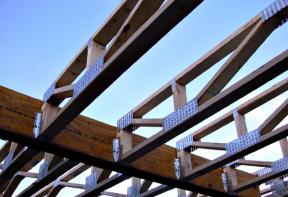Building with composite
Hybrid lumber offers freedom and good looks for decks and other outdoor projects, but it also requires some special considerations
Wood is full of surprises, and not all of them are good. That’s especially true when you’re choosing wood to build outdoors. Just ask anyone who owns a deck that’s more than five years old. What started out as beautiful wood is probably grey, mottled and maybe even a little mouldy. Some folks like this natural, weathered look. Other homeowners want a more refined appearance, so they opt for a finish of some kind when the deck is new.
What they probably don’t realize at the time is that even today’s longest-lasting deck finishes don’t look respectable for more than two or three years. Sure, wood is authentic and structurally effective, but to keep wood looking good outdoors, you need to do a lot of things that are anything but natural: strip the old finish chemically, blast the brown goo off with a pressure washer, apply a deck brightener, pressure wash again, then sand the surface before applying a new finish. Complete two or three stripping and refinishing cycles and the traditional deck maintenance treadmill starts to feel pretty grim. But what are you supposed to do? It’ll be at least 10 or 15 years before the wood rots enough to justify a rebuild–even longer if you designed the project well.
Composite materials promise freedom from the refinishing merry-go-round, but they’re also a bit of a mystery to many do-it-yourselfers. Is the high price of composites worth it? What’s it like working with them? What’s it’s like to live with them? Are hollow or solid composites better? The answers to these questions may surprise you. They may also make you consider choosing composite for your next deck or outdoor furniture project.
Pay now or pay later
Real wood looks better than any composite I’ve seen. At least, when that wood is properly finished and relatively fresh. The appearance of new composites is much more durable, even if real wood starts out more beautiful. Composites change relatively little over time.
When you buy composites, you get two things: a physical building material, plus a good measure of freedom. You don’t have to buy finishing supplies and you don’t have to use them. And if you add up the true costs of labour and finishing real wood over its entire lifetime, it comes out at least as expensive as composites. Sometimes composites are even cheaper than wood in the long run, depending on the value you put on refinishing.
Jump to a section
- Page 1 : About composite materials
- Page 2 : Working with composites
- Page 3 : Carpenter's trickes
To leave a comment, please log in












No comments